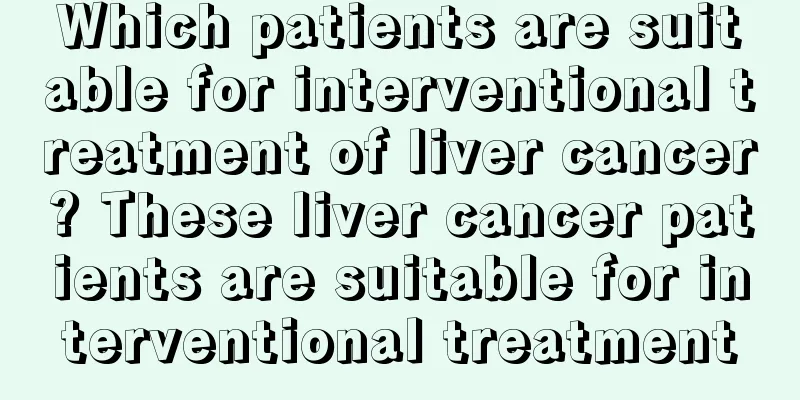Which patients are suitable for interventional treatment of liver cancer? These liver cancer patients are suitable for interventional treatment

|
Treatments for liver cancer include surgical treatment and non-surgical treatment. Surgery is mainly for early liver cancer. In the past, the concept of early liver cancer referred to tumors less than 5 centimeters, but now it usually refers to patients with tumors less than 3 centimeters. The treatment effect is very good for these patients. For patients who cannot undergo surgery, that is, patients with advanced tumors, or early tumors, but have medical diseases, such as heart disease or high blood pressure, etc., these medical factors and patients with severe liver cirrhosis cannot withstand surgery, so other non-surgical treatment methods can be used. After the 1980s, interventional therapy began to be widely used in the treatment of liver cancer in our country. We have a very deep understanding of this aspect, and the technology is also quite mature. Although there are still many academic differences in understanding about when and at what stage liver cancer patients should choose interventional therapy, the general trend now should be that interventional therapy should be the first choice for primary liver cancer that cannot be surgically removed. It does not matter whether these patients are in the early, middle or late stages, as long as they cannot be surgically removed, interventional therapy can be performed. Because the view of most scholars is: liver cancer that can be surgically removed should still be surgically removed. However, many studies in the past have shown that the effect of interventional treatment for small liver cancers is very good, and the five-year survival rate can reach more than 60%. For patients who can be surgically removed, because surgical resection is a radical treatment method, most scholars believe that surgical resection should be the first choice. Pathologically, liver cancer is divided into hepatocellular carcinoma and cholangiocarcinoma, as well as mixed types. Hepatocellular carcinoma accounts for the majority. Hepatocellular carcinoma is characterized by rich blood supply, and interventional treatment is most suitable. The first indication for interventional treatment is that the tumor has rich blood supply. Due to its special biological behavior, cholangiocarcinoma does not have a very rich blood supply. At the same time, cholangiocarcinoma is not very sensitive to chemotherapy and radiotherapy. Interventional treatment cannot perform embolization treatment well and cannot block blood vessels due to the poor blood supply, so the effect of interventional treatment is very limited. From this perspective, interventional treatment of liver cancer is mainly for interventional treatment of hepatocellular carcinoma. Metastatic liver cancer is also treated with interventional therapy. In our daily work, most of our interventional treatments are for patients with liver metastases. The most common are liver metastases from lung cancer, breast cancer, and digestive tract tumors, as well as female genital tumors and urinary system tumors. These tumors are prone to liver metastasis, especially digestive tract tumors. Interventional treatment is very effective for liver metastasis of digestive tract tumors and breast cancer, and is better than systemic chemotherapy. |
Recommend
Normal size of pancreas
The pancreas is an organ in our body. Although th...
Why do I feel pain all over my body after drinking?
The liver is the largest metabolic organ in the h...
What are the common risk factors for lung cancer? Five common high-risk factors for lung cancer
Lung cancer is simply a problem with the lungs. L...
The three most common early symptoms of cardia cancer
Cardiac cancer is the most common malignant tumor...
What liver cancer tests should be done? Four tests you must know to rule out liver cancer
When we feel that we have early symptoms of liver...
What are the benefits of washing your face with salt water?
Salt water not only has anti-inflammatory and bac...
What causes high troponin levels?
Troponin, composed of three subunits, T, C, and I...
What's wrong with coughing up yellow phlegm due to cold
Some people often cough and have a runny nose aft...
Tips for reducing the degree of glasses
Myopia is very common nowadays. Young people nowa...
How to distinguish superficial gastritis from gastric cancer
Gastrointestinal diseases are very common in clin...
Will answering the phone frequently induce brain cancer?
The cause of brain cancer is the same as cancer i...
Which nuts are low in calories
Generally speaking, the nuts we often eat are act...
What foods help digestion and absorption?
During festivals, there are many food choices on ...
The best Chinese medicine hospital for tongue cancer treatment
How to find the best Chinese medicine hospital fo...
Can I eat canned yellow peaches when I have a cough?
Speaking of canned fruits, people may prefer yell...









